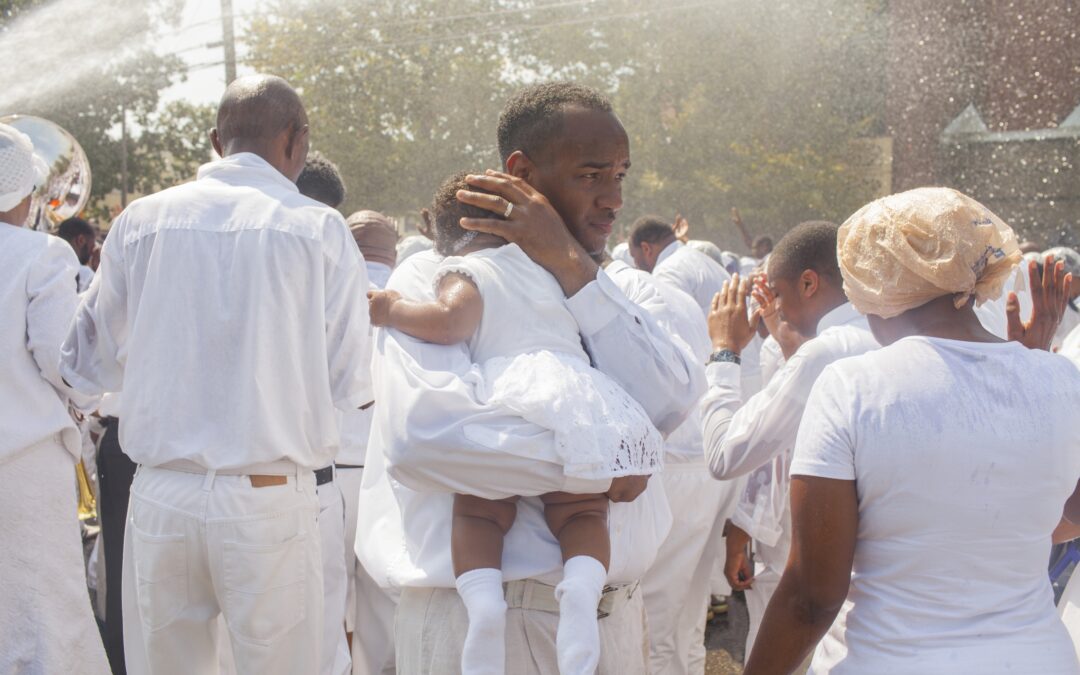Matt Eich (American, b. 1986), Fire hose baptism, Newport News, Virginia (from the series “The Invisible Yoke, Volume III: The Seven Cities”), 2013 Archival pigment print, The Do Good Fund, Inc., 2020–5 © Matt Eich
By Jerome Langston
“I like curating photography shows, because it just seems so natural that a dialogue can be had between one image and the next,” says Chelsea Pierce, Ph.D., the McKinnon Curator of Modern and Contemporary Art, at Norfolk’s Chrysler Museum of Art. It’s the early half of the workweek, and Pierce is guiding me through the storied museum’s current group exhibition, Reckonings and Reconstructions: Southern Photography from the Do Good Fund, which opened last month. It’s relatively early in the afternoon, but post-lunch—so there aren’t that many visitors to the museum, roaming around. Pierce, whose arrival to the museum as a new curator, was announced just June of last year, has an engaging personality, and we therefore discuss much—on the subject of fine-art photography, in these challenging times.
Organized by the Georgia Museum of Art, Reckonings and Reconstructions: Southern Photography from the Do Good Fund, was on view at the Athens, Georgia museum, from October 2022 through the first week in January of this year. Following its run at the Chrysler, the exhibition will head to the Lowe Art Museum, at the University of Miami. The 100-plus photographs featured in the show, representing the varied work of 73 impactful artists—diverse in age, gender, race, and even region of origin—make up the first large-scale exhibition of the Do Good Fund’s expansive collection of Southern photography, focusing on the 1950s to present. Many of the artists featured are connected of course to Georgia, but there are many that are not. The Do Good Fund was founded in 2012, and is a public charity based in Columbus, Georgia, whose collection of art focuses solely on the American South. The traveling exhibition was put together by American art curator at the Georgia Museum of Art, Jeffrey Richmond-Moll.
Though initially unfamiliar with the work of many of the younger artists, this intriguing exhibition, which challenges many of society’s deeply ingrained southern tropes, features several icons of American photography: including the late Gordon Parks and William Christenberry, as well as the remarkable Baldwin Lee, whose art I also previewed for Veer, and had the pleasure of meeting for his solo show, Baldwin Lee: The South in Black and White, which ran for months at the Chrysler, back in 2012. Lee is a master of documentary photography and was also a student of the great Walker Evans. One of his many brilliant, monochrome works, Basketball Players at Night, Monroe, LA, 1985, is featured in this show, as is Parks’ Mr. And Mrs. Thorton, Mobile, Alabama, 1956. Both works are part of the “Kinship” themed section of the exhibition.
When entering the sizable gallery space for this group show, you are soon greeted by the first themed section, “Land,” which includes some evocative works by the likes of William Ferris, Paul Kwilecki, and Carolyn Drake. That section is followed by “Labor,” which showcases works by artists like Carl Martin and Alex Harris, whose Migrant Worker piece, is exceptional. And then there’s “Law & Protest,” with newer works by Sheila Bree Bright and Ruddy Roye. In those 3 themed sections alone, a wide range of diverse, artistic voices are displayed through the medium of photography, even as they all speak to aspects of the southern American experience.
“Over the years, it’s normally been well-known white male photographers behind the camera,” notes Pierce, about half-way through my guided tour of the show. “And now, you see much more diverse artists represented in the Do Good Fund.” The section called “Ritual,” is probably my favorite of the themes. “This section has some different images of ritual, both secular and religious,” says Pierce. “Ritual” explores the range of cultural expression and experience that are largely southern in origin, or at least typically southern in practice. Multiple works by artist William K. Greiner, and a piece by Andrea Morales, really stand out in this section. And then there’s also the section exploring “Food,’ as it pertains to southern experience—but not primarily images of southern cuisine. The aforementioned section, “Kinship,” provides the narrative closure.
Following my viewing of the well-curated exhibition, I chat by phone, with photographic essayist, Matt Eich, who is now based in Charlottesville, but spent quite a few years in Hampton Roads as well. His art is widely published through his Little Oak Press imprint, and his long-form projects that explore the American condition, as well as other themes, have been widely exhibited. He also teaches at the Corcoran School of the Arts & Design at George Washington University.
One of his works in the Chrysler exhibition, is entitled Firehose baptism, Newport News, Virginia, and it features a striking image of a young black man holding a little girl, as a firehose baptism is commencing in the background. That type of mass baptism was long associated with the United House of Prayer. I ask Eich about the experience creating the work.
“I’d heard from a friend that it was going down in Newport News, so I ended up going out there. I think it was maybe one or two other photographers that were there with me, and we just sort of showed up, because we didn’t know who to ask…” Eich says. It was difficult to capture the moment photographically, because of all the water from the fire hoses. The image that is captured in the work really spoke to him as a father of girls. “It was a very chaotic scene, but that moment felt like a distillation, for me, and also had this larger symbolism to it, built in.”
WANT TO SEE?
Reckonings & Reconstructions: Southern Photography from The Do Good Fund
Through November 5
Chrysler Museum of Art




